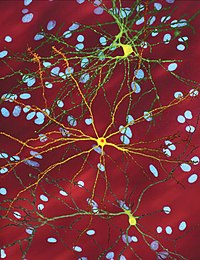
Photo from wikipedia
Alzheimer’s disease (AD) is a progressive neurodegenerative disease with an insidious onset and multifactorial nature. A deficit in neurogenesis and synaptic plasticity are considered the early pathological features associated with… Click to show full abstract
Alzheimer’s disease (AD) is a progressive neurodegenerative disease with an insidious onset and multifactorial nature. A deficit in neurogenesis and synaptic plasticity are considered the early pathological features associated with neurofibrillary tau and amyloid β pathologies and neuroinflammation. The imbalance of neurotrophic factors with an increase in FGF-2 level and a decrease in brain derived neurotrophic factor (BDNF) and neurotrophin 4 (NT-4) in the hippocampus, frontal cortex and parietal cortex and disruption of the brain micro-environment are other characteristics of AD. Neurotrophic factors are crucial in neuronal differentiation, maturation, and survival. Several attempts to use neurotrophic factors to treat AD were made, but these trials were halted due to their blood-brain barrier (BBB) impermeability, short-half-life, and severe side effects. In the present review we mainly focus on the major etiopathology features of AD and the use of a small neurotrophic and neurogenic peptide mimetic compound; P021 that was discovered in our laboratory and was found to overcome the difficulties faced in the administration of the whole neurotrophic factor proteins. We describe pre-clinical studies on P021 and its potential as a therapeutic drug for AD and related neurodegenerative disorders. Our study is limited because it focuses only on P021 and the relevant literature; a more thorough investigation is required to review studies on various therapeutic approaches and potential drugs that are emerging in the AD field.
Journal Title: Biomolecules
Year Published: 2022
Link to full text (if available)
Share on Social Media: Sign Up to like & get
recommendations!